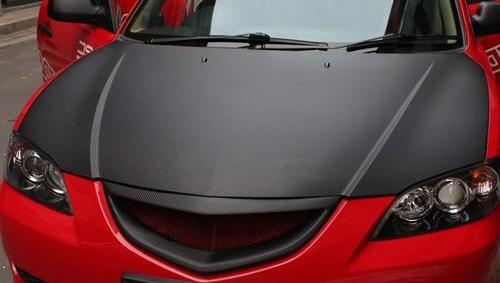The term "carbon pasting" most often means pasting a vinyl self-adhesive film that mimics the texture of carbon. The main advantages of using carbon film in comparison with classical painting are less time and material costs (there is no need for preliminary priming of the surface, and there is no need to wait until the soil and paint have dried), the possibility of self-pasting with carbon fiber, and a minimum set of tools. There are two types of pasting: “dry” and “wet”. Next will be described pasting carbon fiber car parts by the "dry" method.
Necessary tools
When working, you will need: a carbon film itself with channels for air outlet, a hairdryer (it’s better to build, but you can also use the usual one for drying hair), scissors, an office knife, a clean soft cloth, it is also desirable to have a squeegee and primer for a vinyl film. The thicker the film, the better it hides the unevenness of the surface to be glued, but a very thick film glues worse in the places of the turn, the thickness of 200 microns is considered optimal.
Surface preparation
The durability of the film coating largely depends on the quality of this stage. First of all, it is necessary to get rid of chips, cracks, dents, as well as foci of corrosion on the coating, for this you can use automotive putty. After drying, the places covered with putty should be cleaned with sandpaper with a grain size of at least 300. Then it is necessary to thoroughly wash the glued surface from dirt and degrease with gasoline or solvent.
Cut a piece of film of the right size, this size is the sum of the area of the part and the margin for turning on all sides. It is better to take a larger stock - up to 8-10 centimeters for large parts. It is important that the lines of the drawing on adjacent parts are directed in the same direction.
Carbon pasting begins with straight sections. Tucking is the last thing to do. The hair dryer heated film can be stretched, and due to this, uneven surfaces are glued. Air from under the pasted film is expelled with a squeegee or cloth from a cent to the edges. If there is a primer, then the edges of the part to be glued are smeared with them to enhance adhesion in the places of the undercoat. Car pasting with carbon fiber is carried out according to the principle: one part - one piece of film. Do not overheat or stretch the film too much, otherwise you will violate the structure of its surface, such a defect will be clearly visible. After pasting for several weeks, it is better not to wash the car and do not drive at high speed, so that the film sat down and "remembered" the shape of the car.

If the air after pasting still remains under the film, then it is necessary to squeeze this place with a damp cloth, and then warm it with a hairdryer, when heated, the film is compressed and the defect will most likely not be noticeable. Carbon pasting is carried out according to the same principle, only the dimensions of the parts are usually smaller and they have a more complex shape.
If you follow these simple tips, then pasting carbon fiber car will be a simple task for you, and the result of the work will please you and your friends.